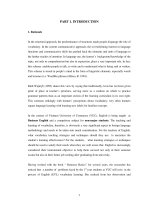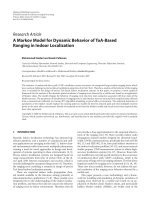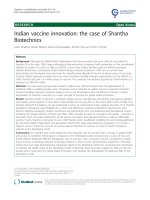Improving start up performance through business model innovation a case of start up firms in ba ria vung tau province (tt)
Bạn đang xem bản rút gọn của tài liệu. Xem và tải ngay bản đầy đủ của tài liệu tại đây (505.29 KB, 10 trang )
ISSN No:-2456-2165
Improving Start-up Performance Through Business
Model Innovation: A Case of Start-up Firms in Ba Ria Vung Tau Province
Trần Nha Ghi
Abstract:- This study examines the relationship between
components of business model innovation and start-up
performance of start-up firms in Ba Ria - Vung Tau
province. This relationship is verified based on a sample of
425 start-up owners. The findings show that components of
business model innovation positively influence start-up
performance. In conclusion, the study proposes policy
implications for start-up firms and suggests directions for
further researches.
Keywords:- Business model innovation, start-up performance.
I.
INTRODUCTION
Trimi and Berbegal-Mirabent (2012) have expanded the
theory of business model innovation (BMI) applied to start-up
firms, a recently new topic that is gaining increasing interest
among researchers. BMI will help start-ups to make right
decision in order to enhance their chance of success. Initially,
the chosen business model for start-ups must be relevant, if
not, they have to innovate it in order to establish competitive
advantages and efficiency (Aspara, Hietanen and Hietanen,
2010). In perspective, the stable firms are required to have an
effective evaluation for changes in components of the business
model. BMI is closely in line with vision, creative ability and
intuition in business (Foss and Saebi, 2016). Therefore, BMI
is very essential for start-ups as well as stable businesses.
In the context that Vietnam is stepping up the start-up
movement, for start-up firms, surviving in the early years
would be a difficult process. In Vietnam, according to GEM
(2016), the percentage of the business activities under the
start-up stage was 13.7%, including the percentage of the start
up firm (less than 3 months) of 1%, and the proportion of the
successful start-up (under 3.5 years) of 12.7%. Failure of the
start-up firms was yet to build quality relationship and BMI
(Nguyen Quang Thu et al., 2016). The study referred to the
start-up failure to innovate business model that impacts the
performance. This relationship has not been verified by
international studies as well as in Vietnam.
Ba Ria - Vung Tau (BRVT), a province located in the
Southern key economic region of Vietnam, has a significant
attention to innovative creations for start-ups. The province
has facilitated the start-up ecology and creations innovation,
creating a favorable environment to boost the formation and
development of potentially fast-growing firms by exploiting
intellectual property, technologies, new business models
(Decision No. 3380/QD-UBND). Therefore, this study aims to
achieve three objectives: (1) Identify the components of
business innovation; (2) Examine the relationship between
business innovation and start-up performance; (3) Give
managerial implications to improve the start-up performance.
The survey participants are the owners of the private firms
operating in BR-VT province, excluding those operating in the
financial sector.
The structure of the paper is composed of the following
sections: introduction, literature review, data and
methodology, findings and discussions, conclusions and
managerial implications.
II.
LITERATURE REVIEW
A. Theoretical basis and analytical framework
• Differentiate between start-up andfirms
According to Decision No. 448 / QD-TTg on the
approval of the Project of start-up ecosystem and innovative
content development by the National Economic Advisor to
2025, "Start-ups are individuals and organizations with rapid
growth projects based on new technology and business model
in an operating period not exceeding 5 years from the date of
issuance of the first registration certificate. " Businesses
operating over 5 years have been stabilized, developed,
considered to be a firm. According to the GEM (2016) in less
than 3.5 years, start-up firms were likely to fail, the successful
rate was just at 12.7%; Over-3.5-year start-up firms have been
considered as being stable. Based on the view of GEM (2016),
this study will only regard to the start-up firms operating for
no more than 3.5 years.
Often, state firms typically take place in the technology
sector. In Vietnam in general and BRVT in particular, newly
established firms operate in multiple fields. There are new
market entrants with traditional family trades in order to
fullfill employment issues for themselves and their families,
which are less innovative and creative but capable of rapid
growth. In addition, firms start in the field of information
technology, applications of technology are required to bring
creativity. In this study, regardless of any field of activity
among start-ups, the common default is the start-up businesses
operating less than 3.5 years.
• Business model innovation
Business model innovation is to restructure the course of
action in the existing business model to create innovative
ISSN No:-2456-2165
products / services , a streamlined method of renovation
because the resources and capabilities are available to save the
investment to a minimum (Santos et al., 2009). Aspara (2009)
defined an innovative business model as a constantly strategic
alternating option. In order to build a sustainable firm, it is
necessary to renovate the business and its components
(Carayannis, Sindakis and Walter, 2014). The three
components of business model are value creation, value
proposition and value capture, BMI is to change these three
components (Baden Fuller and Mangematin, 2013). Spieth and
Schneider (2013) have developed BMI components such as
value creation innovation, value structure innovation and
revenue model innovation.
Clauss (2016) has developed a measurement model for
BMI that includes:
New capabilities suggest that firms need new capabilities
to innovate in order to capture opportunities arising from the
external environment (Teece, Pisano and Shuen, 1997). New
capabilities are developed through training, education,
knowledge integration, development, exploration of new ideas
and lessons learned (Achtenhagen, Melin and Naldi, 2013).
New technologies/equipment centers on technological
resources needed to carry out BMI. Wei et al. (2014)
demonstrated the significance of allocating technological
advances to an appropriate BMI to be successful. Firms need
to acquire new technology to restructure business model. For
example, new products/services may require new production
technology, and new revenue models will require new
technical system for payment.
New processes/structures refer to the way in which
activities and tasks in the business model can be embedded.
(Zott and Amit, 2010). Casadesus-Masanell and Ricart (2010)
show that the process/structure of the system determines the
performance of business model.
New partnerships: with suppliers, customers or
competitors represent the external resources for BMI.
Strategic partners are the important external resources that
businesses cannot develop at the moment (Dyer and Singh,
1998). BMI is complex and requires support from partners,
businesses need to find new partners and maintain the existing
relationship (Bierly and Gallagher, 2007).
New products/services suggest firms’ offers to address
customer problems or meet their needs in new or better ways
(Johnson, Christensen and Kagermann, 2008). Innovation of
products/services relies on research and development or use of
new technologies (Teece, 2010). The new products/services is
the most obvious change in a firm’s BMI.
New customer segments/markets relate to the customer
groups or market segments that the company provides current
or future products/services (Afuah, 2014). BMI is to redefine
the current market or penetrate new markets. The target
market is determined by the question "Who is willing to pay
for products/services provided by the company?" (BadenFuller and Haefliger, 2013).
New distribution channels relate to the delivery of value
to customers (Baden-Fuller and Mangematin, 2013).
Distribution is done in a variety of ways, especially for
intangible goods or services (Osterwalder et al., 2005). For
example, Dell is a company that has built its business model
upon the direct distribution channel to consumers without the
involvement of retailers.
New customer relationships are the ability of the
business to build present relationships or establishment of new
relationships with customers. Establishment of new customers
is the key to BMI when products/services can be replaceable
or the market has become mature. The customer relationship
will provide up-to-date environmental information and
potential market demands, leading to a change in Business
model (Chesbrough, 2006).
New revenue models state that customers pay for the
value proposition (Afuah, 2014). Questions related to this
issue include "When is the revenue generated?", "How long is
the revenue generated?", "Who is the revenue generator?"
(Baden-Fuller and Haefliger, 2013).
New cost structures are direct and indirect costs
associated with business operations (Casadesus-Masanell and
Ricart, 2010). The established cost structure will determine the
strategic scope of products/services and the suitability of the
market strategy (Zott and Amit, 2008). Cost structure in a
business model will be changed by the corporate strategy.
• Start-up performance
Littunen, Storhammar and Nenonen (1998) defined start
up performance as existence/survival over the first three years,
continuing after the start of business. Start-up performance is
influenced by many factors: entrepreneurial characteristics,
characteristics of firms, results of the initial start-up phase and
impacts from the environment. The continuation of business
activities is a sign of success for start-up performance, the
early operating years of the business are highly important to
stabilize business activities in the long run. According to the
assessment of business development in Vietnam, GEM (2016)
has developed two indicators: the ratio of start-up business
activities and the ratio of business activities have been stable.
Based on the point of view of GEM (2016); Littunen,
Storhammar and Nenonen (1998), Nguyen Dinh Tho and
Nguyen Thi Mai Trang (2009), start-up performance is
understood as the existence of firms in the start-up phase (over
3 months and less than 3.5 years), which is persistently stable
and able to achieve goals set for start-up individuals (revenue,
profit and market share as desired).
• The relationship between business innovation and business
start-up performance
The criterial consequences for BMI are the economic
effects (profitability, productivity, return on turnover, market
value) and value capture (Andreini and Bettinelli, 2016).
ISSN No:-2456-2165
Pedersen, Gwozdz and Hvass (2016) demonstrated a
correlative relationship between business innovation and
financial efficiency. Cucculelli and Bettinelli (2015) found
that firms adjusting business model over time and innovating
had the same effect on the use of venture capital. Hence, based
on the criterial outcomes for BMI, this study continues to
assess the relationship between BMI and start-up performance
in BR-VT province.
B. Empirical studies review
Spieth and Schneider (2013) based on the business
model and product innovation theory, defined BMI as business
innovation that has effect to at least one out of three
components in the business model, including value creation,
value structure and revenue model.
Guo, Su and Ahlstrom (2015), based on data
investigation of the Chinese businesses, indicated a positive
relationship between exploratory orientation, opportunity
identification and BMI.
Zhang, Zhao and Xu (2015) demonstrated firms with
existing competitive advantages have to change their business
model. The finding was to enhance the subject of business
model, knowledge provision and suggestions to BMI.
Velu (2015) studied the impacts of the BMI on the newly
established firms. The data survey included 129 businesses in
the U.S bond market, period 1995-2004. The finding showed
that firms with high degree of BMI would survive longer than
those with moderate level.
Waldner, Poetz, Grimpe and Eurich (2015) investigated
how different stages in an industry’s life cycle influence BMI
and performance. Based on a sample of 1.242 Austrian firms,
the result suggested that BMI should be carried out in the
emergent stage of the industry’s life cycle.
Pedersen, Gwozdz and Hvass (2016) assessed the
impacts of BMI on financial efficiency based on survey
responses from 540 managers in different majors, such as
marketing, logistics, finance and others. Results showed that
BMI effect positively to the financial efficiency with an
intermediate role of the business sustainability.
Bouncken and Fredrich (2016) researched in size, age,
experience and corporation duration effect to the BMI’s
retained value and BMI have a positive effect on Return on
Equity (ROE), even stronger than the mature businesses.
Based on the researches mentioned above, none of them
have looked at the relationship between BMI and start-up
performance. It was also a research suggested by Foss and
Saebi (2016) when integrating researches about BMI from
2000 to 2015.
C. Data and research methods
From existing theories and related researches, this
research uses 10 factors from Clauss’s BMI (2016). Pertaining
to the result from group discussion with specialists, as the
start-ups come into operation, its components within will
connect activities and tasks with each other so that there is no
need to reconfigure procedures/structures. For example,
Canvas BMI is composed of nine components, helping start
up firms to merge business activities to create value for
customers and value capture (Osterwalder & Pigneur, 2010).
Hence, Clauss’s factors to procedure/structure innovation are
not in use for the start-up firms in Ba Ria-Vung Tau.
According to the theoretical basis and the result of
qualitative researches, the suggested conceptual framework
contains nine factors of BMI: capability innovation,
technology innovation, partnership innovation, product
innovation, market innovation, distribution channel
innovation, customer relationship innovation, revenue model
innovation, cost structure innovation and the dependent
variable is start-up performance (see Figure 1.).
ISSN No:-2456-2165
Fig 1:- Recommended research model
Foss and Saebi (2016) research BMI period 2000 - 2015.
Research results show that BMI is executed for reducing costs,
introducing new products, accessing new markets and
improving the level of efficiency of the financial performance.
BMI enhances competitive advantage, profitability, creativity
and efficiency (Zott and Amit, 2007).
Based on the criterial consequences of BMI (Pedersen,
Gwozdz and Hvass, 2016), integrated results and research
proposals on BMI of Foss and Saebi (2016), period 2000
2015. The result from group discussion of specialists indicated
that new changes of business model components would
contribute to start-up performance improvement.
Alam (2013) demonstrated a positive relationship
between capabilities innovation and operating performance of
the Malaysian manufacturing firms. Based on that, the H1
hypothesis is stated:
H1: There is a positive relationship
capabilities innovation and start-up performance.
between
Reichert and Zawislak (2014) assessed the relationship
between technological capabilities and firm performance of
133 firms in Brazil. Results showed that they had a positive
relationship. Therefore, technology innovation will positively
affect the performance of firms. From the analysis above, the
hypothesis H2 is proposed:
H2: There is a positive relationship between
technological innovation and start-up performance.
During the start-up stage, start-up firms work intensively
with partners to be supported of external resources. Goerzen
and Beamish (2005) surveyed 580 firms to examine the impact
of the cooperative network on firm performance. Research
results show that firms with more experience of cooperation
would gain much firm performance than those with little
experience of cooperation. Partnership innovation positively
affects firms performance. Thus, the H3 hypothesis is
proposed:
H3: There is a positive relationship between partnership
innovation and start-up performance.
Markets innovation focuses on developing the target
market and identifying the best way to serve the target market
(Shirokova and Socolova, 2013). Therefore, start-up firms
need to innovate offerings, distributing channels to satisfy
demands; bring value to customers and firms performance.
Atalay, Anafarta and Sarvan (2013) have demonstrated
positive relationships between offerings innovation, processes
innovation and performance of the automotive supply industry
in Turkey. From the basis of analysis above, the hypothesis
H4, H5 and H6 are as the followings:
H4: There is a positive relationship between offerings
innovation and start-up performance.
H5: There is a positive relationship between markets
innovation and start-up performance.
H6: There is a positive relationship between channels
innovation and start-up performance.
ISSN No:-2456-2165
Customers make revenue for the firm, customer
relationship management will help the firm use data and
information to understand customers and create value for them
(Payne and Frow, 2005). Customer relationships innovation
will help firms find new customers and bring value to firms.
Haislip and Richardson (2017) demonstrated that customer
relationship management has a positive effect on performance.
Therefore, customer relationships innovation will generate
revenue that leads to firms efficiency. We have the hypothesis
H7, Hb is stated:
H7: There is a positive relationship between customer
relationships innovation and start-up performance.
H8: There is a positive relationship between revenue
models innovation and start-up performance.
During the start-up stage, start-up firms incurred much
cost of their initial investment and fixed investment. Cost
structure determines firms performance. Cost structures
innovation is to identify the types of costs required in relation
to firms operation at the lowest level. Hypothesis H9 is stated:
III.
DATA AND METHODOLOGY
A. Data
This study uses direct interview technique and e-mail
sending with a detailed questionnaire with a 5-level Likert
scale (from 1: completely disagree to 5: fully agree). The
interviewees are the start-up owners in Vung Tau, Ba Ria, Tan
Thanh, Dat Do and Long Dien. Interview time is on 8/2017.
Constructs in the research model were developed based
on the original scales from previous studies and were adjusted
following qualitative research. The research model has 10
research concepts with 35 observation variables as shown in
Table 1.
Number of
observations
Constructs
Business model
innovation
H9: There is a positive relationship between cost
structures innovation and start-up performance.
Capabilities Innovation (CAP)
3
Technological Innovation (TEC)
3
Partnerships Innovation (PART)
4
Offerings Innovation (OFF)
3
Markets Innovation (MARK)
3
Distribution channels innovation
(CHAL)
Customer Relationships Innovation
(REL)
Clauss (2016)
3
3
Revenue Models innovation (REV)
4
Cost Structures Innovation (COST)
4
Startup performance (STARTPER)
Sources
5
Pirolo & Presutti (2010),
Nguyễn Đình Thọ & Nguyễn Thị Mai
Trang (2008)
Table 1. Key concepts in model and construct sources
Sample:
Sample was selected conveniently upon the principle 5:1
(Bollen, 1989). The model has (35 observation variables) * 5
= 175. Therefore, the minimum sample size for this method is
175. However, in order to obtain an estimate for the Structural
Equation Modeling (SEM), the sample size must be larger
than 200 (Hoelter, 1983).
According to Yamate (1967), if you know the population, use
N
n =
the following formula:
------ y
1 + ^ -e
Where n is the sample size; N is the population; e is the
standard error.
According to statistics from BRVT provincial
Department of Science and Technology (2017), the number of
start-up firms established between 2014 and 2017 was 4470,
with a 95% confidence level, the significant level is at 5%.
Estimated sample size:
4470
n ------------------------- - =
1+ 4470 ^ 0 .052
367
During the data collection had to remove the
unsatisfactory surveys. The sample size added 25% of the
ISSN No:-2456-2165
minimum sample size: 367*(1+25%) = 459. So the number of
survey questionnaires was 459, collected 431, excluding 6
invalid questionnaires. The remaining formal sample was 425.
B. Methodology
The research methodology was implemented through
two stages: (1) preliminary research; and (2) formal study.
Preliminary qualitative research: used to adjust the
observational variables in the measurement of the research
concepts. The authors worked in groups discussion techniques
so that their scales were clearly understood and conceptually
identical.
Carried out a group discussion with 5 experts, including
2 scientists and 3 successful start-up owners. The preliminary
qualitative results removed the "process/structure innovation"
construct of BMI. The research model contains 9 independent
variables, which are the components of BMI, and a dependent
variable of start-up performance. There was a new
observational variable added to the scale of start-up
performance. The interview results were confirmed, developed
and adjusted to the draft scale.
Preliminary quantitative research: The draft scale was
used for the sample interviews with 101 firms by means of
convenient sampling to test the reliability of the scale. After
this step, the scale was completed and used for formal
quantitative research. A preliminary quantitative research was
conducted to evaluate the scale using reliability Cronbach's
Alpha and exploratory factor analysis (EFA).
Formal research: conducted by a quantitative research
through 425 start-up firms surveys at BRVT to test model and
research hypothesis.
IV.
FINDINGS AND DISCUSSION
A. Findings
The first set of research concepts were evaluated using
reliability (Cronbach's Alpha) and exploratory factor analysis
(EFA). Then verified through aggregated reliability,
convergent value, and discriminant value by mean of
Confirmation Factor Analysis (CFA). Structural Equation
Modeling (SEM) method was used to test the theoretical
model and hypotheses. The estimative method was Maximum
likelihood (ML).
The proposed initial scale had 10 constructs with 35
observational variables. The results of the pre-test and the
affirmation test showed that there was an observational
variable in the Cost Structure construct (cost4) rejected. The
result of the scale test was presented in Table 2.
Reliability
Contructs
Number of variables
Cronbach’s Alpha (a)
Composite (pc)
Variance
extract (pvc)
Capabilities Innovation (CAP)
3
0.837
0.840
0.636
Technological Innovation (TEC)
3
0.824
0.826
0.613
Partnerships Innovation (PART)
4
0.877
0.878
0.645
Offerings Innovation (OFF)
3
0.823
0.871
0.693
Markets Innovation (MARK)
3
0.800
0.805
0.581
Channels Innovation (CHAL)
3
0.855
0.856
0.664
Customer Relationships Innovation (REL)
3
0.823
0.830
0.621
Revenue Models Innovation (REV)
4
0.877
0.879
0.645
Cost Structures Innovation (COST)
3
0.850
0.837
0.657
Startup Performance (STARTPER)
5
0.869
0.867
0.568
Table 2. Summary table of test results
a ue
Satisfied
ISSN No:-2456-2165
The result of the CFA analysis with the critical model
showed that the Chi-squared statistic was 665,258 with 481
degrees of freedom (df), p = 0.000. If the degree of freedom is
CMIN / df = 1,383 <2, satisfactory compatibility. Other
indicators, such as GFI = 0.915, TLI = 0.971, CFI = 0.976,
RMSEA = 0.030 <0.80, were satisfied. Thus, it can be
concluded that the critical model achieved the level of
compatibility with market data.
The result of the SEM (Figure 2) analysis: the theoretical
model has 482 degree of freedom (df), x2[482] = 668.117, p =
0.000, CMIN/df = 1.386, GFI = 0.915, TLI = 0.970, CFI =
0.975, RMSEA = 0.03. It should be noted that the Heywood
phenomenon does not appear in the estimation of CFA, SEM
models. Therefore, it can be concluded that this model is
appropriate for market data.
Fig 2:- SEM results of the theoretical model (standardized)
Results of key parameters are presented in Table 3.
Accordingly, technological innovation has the most positive
impact on the start-up performance (H2 : P = 0.202, p = 0.000);
Next, there is a positive effect on the start-up performance
from markets innovation (H5 : P = 0.193, p = 0.003) and cost
structures innovation (H9 : P = 0.185, p = 0.004), p = 0.000)
and capabilities innovation (H1 : P = 0.155, p = 0.000).
Offerings innovation has a positive effect on the start-up
performance (H4 : P = 0.153, p = 0.000); followed by the
positive effect from revenue models innovation (H8 : P = 0.143,
p = 0.000) and customer relationships innovation (H7 : P =
0.119; p = 0.005). Finally, partnerships innovation has the
least positive effect on start-up performance (P = 0.114, p =
0.000). Thus, 9 hypotheses are accepted (H1 , H2 , H3 , H4 , H5 ,
H6 , H7 , H8 , and H9 ), none of the hypotheses mentioned are
rejected.
Relationship
Estimate
S.E
C.R
Pvalue
Startper
<—
PART
0.114
0.028
4.019
0.000
Startper
<—
TEC
0.202
0.043
4.657
0.000
Startper
<---
OFF
0.153
0.044
3.461
0.000
Startper
<---
MARK
0.193
0.041
4.706
0.000
Startper
<---
CHA
0.158
0.043
3.687
0.000
Startper
<---
REL
0.119
0.042
2.821
0.005
Startper
<---
REV
0.143
0.036
3.938
0.000
Startper
<---
COST
0.185
0.048
3.839
0.000
CAP
0.155
0.043 3.586 0.000
Startper <--Table 3. Result of relationship test between concepts
(standardized)
B. Discussions
The proposed research model has 10 unidirectional
research constructs: capabilities innovation, technological
innovation, partnerships innovation, offerings innovation,
markets innovation, distribution channels innovation and
customer relationships innovation, revenue models innovation,
cost structures innovation and start-up performance. The
constructs have 35 observational variables, after the
ISSN No:-2456-2165
preliminary tests and CFA, the scale has rejected one
observational variable (cots4).
The result of the measurement model shows that the
scale values achieve reliability (Cronbach Alpha coefficient,
composite reliability) and approvable values (unidirectional,
extraction deviation, convergent and distinguish).
The research findings have added to the conceptual
framework a positive relationship between the components of
BMI and start-up performance. This relationship have not
been testified from previous studies. The research findings
have supplemented the research problem of Foss and Saebi
(2016) between BMI and firms performance.
V.
CONCLUSIONS AND MANAGERIAL
IMPLICATIONS
A. Conclusions
This research has demonstrated the relationship between
the innovative components of BMI and start-up performance
of the start-up firms in BRVT province. Research results show
that capabilities innovation, technological innovation,
partnerships innovation, offerings innovation, markets
innovation, channels innovation, customer relationships
innovation, revenue models innovation and cost structures
innovation have positive effects on the start-up performance.
Therefore, these hypotheses Hi , H2 , H3 , H4 , H5 , H6 , H7 , Hs and
H9 are accepted.
B. Limitations and research direction
This study was conducted in BRVT province so that the
representativeness was not high. Therefore, in order to
improve the level of representativeness, the research should be
retaken in other provinces/cities, such as Ho Chi Minh City,
Dong Nai, Binh Duong, Can Tho ... are places whose many
start-up firms.
This study examined the firms from various sectors, so it
could not distinguish the specific characteristics and
requirements in each sector. For a better test result, it is
essential to take a research on a specific sector to see the role
of BMI in improving start-up performance.
There are other factors that affect start-up performance:
quality of relationships with strategic partners ... These are the
issues proposed for further researches.
C. Managerial implications
The components of BMI are proven to have a positive
effect on start-up performance. Therefore, start-up firms
should focus on BMI to improve start-up performance. Here
are the specific managerial implications:
Technological innovation (fi = 0,202): start-up firms
update technological resources, technical equipment
development versus competitors, and utilize new potential
technology to expand the offerings portfolio. Especially in the
era of industrial revolution 4.0, start-up firms proactively
approach differently from the previously-done approaches,
improve management competencies, technology and
investment in technological
manufacturing against
international standards ... Hence, start-ups are possibly ready
to adapt to the industrial revolution 4.0 (Minh Phuong, 2017)
Markets innovation (P = 0.193): start-up firms are
required to capture opportunities in new segments or
developing markets, always put an interest in new market
segments, unoccupied markets, searching for customer
segmentation and new markets for offerings.
Cost structures Innovation (P = 0.185): start-up firms
assess pricing strategies, actively seek opportunities to save
production costs , regularly monitor and adjust the production
costs over market prices and take advantages of opportunities
arising from differentiated strategies.
Channels innovation (P = 0.158): start-up firms use new
distribution channels for offerings, and change distribution
channels to improve channel efficiency.
Capabilities innovation (P = 0.155): start-up firms foster
staff to be trained in order to acquire knowledge, cognitive
ability and new capabilities development. Start-up firms
examine new capabilities needed to be established to adapt
with demanding changes in the market.
Offerings innovation (P = 0.115): start-up firms are
interested in new unfulfilled customers’ needs, innovating
offerings to meet customer needs versus competitors.
Revenue models innovation (P = 0.143): start-up firms
develop new revenue opportunities, providing extra
convergent services to receive long-term profits, replenish or
replace revenue of the full payment method by long-term
installment payment (for example: lease contract).
Customer relationships innovation (P = 0.111): start-up
firms enhance customer retention with new services, focusing
on innovative creations to increase customer retention.
Finally, Partnerships innovation (P = 0.144): start-up
firms seek new partners to cooperate with, exert the
opportunities provided by cooperation, evaluate the potential
benefits of using external resources and receive supports of
partners to develop BMI.
REFERENCES
[1] . Nguyễn Đình Thọ và Nguyễn Thị Mai Trang (2008).
‘Năng lực cạnh tranh động của doanh nghiệp Việt Nam.
Nghiên cứu khoa học trong quản trị kinh doanh’. NXB
Thống Kê, 2009.
[2] . Nguyễn Quang Thu, Ngô Quang Huân và Trần Nha Ghi
(2016). ‘Mối quan hệ giữa nguồn lực doanh nghiệp, năng
lực động và kết quả hoạt động của các doanh nghiệp đã
khởi nghiệp tại tỉnh Bà Rịa Vũng Tàu. Hội thảo khoa học
khởi nghiệp tại Việt Nam: Cơ hội & thách thức trong thời
kì hội nhập’. NXB Kinh tế TP. Hồ Chí Minh.
[3] . Minh Phương (2017). Khởi nghiệp cùng cách mạng công
nghiệp 4.0. />
ISSN No:-2456-2165
mang-cong-nghiep-4-0/c/23620819.epi(Truy cập ngày
11/01/2018).
[4] . Achtenhagen, L., Melin, L., and Naldi, L. (2013).
‘Dynamics of business models-strategizing, critical
capabilities and activities for sustained value creation’.
Long Range Planning, 46, 1-25.
[5] . Alam, S. S. (2013). ‘Relationships between innovation
capabilities,
business
performance,
marketing
performance and financial performance: A literature
review business and management horizons’. (Vol. 1).
ISSN 2326-0297, No. 159.
[6] . Andreini, D. (2016). ‘Business Model Innovation: From
Systematic Literature Review to Future Research
Directions’.
International
Series
in
Advanced
Management Studies Business Model Innovation.
[7] . Aspara, J. (2010). ‘Business model innovation vs
replication: financial performance implications of
strategic emphases’. Journal of Strategic Marketing 37
41. />[8] . Afuah, A. (2014). ‘Business Model Innovation: Concepts,
Analysis, and Cases’. New York: Routledge.
[9] . Atalay, M., Anafarta, N., and Sarvan, F. (2013). ‘The
relationship between innovation and firm performance:
An empirical evidence from Turkish automotive supplier
industry’. Procedia - Social and Behavioral Sciences, 75,
226-235.
[10]. Bierly, P.E. and Gallagher, S. (2007). ‘Explaining
alliance partner selection: fit, trust and strategic
expediency’. Long Range Planning, 40, 134-153.
[11]. Baden-Fuller, C. and Haefliger, S. (2013). ‘Business
models and technological innovation’. Long Range
Planning, 46, 419-426.
[12]. Baden-Fuller, C., and Mangematin., V. (2013).
‘Business models: A challenging agenda’. Strategic
Organization, 11(4), 418-427.
[13]. Bollen, K. A. (1989). ‘Structural Equations with
Latent Variables’. New York, NY:Wiley.
[14]. Bouncken, R. B, and Fredrich, V. (2016). ‘Learning
in coopetition: Alliance orientation, network size, and
firm types’. Journal of Business Research,69(5),17531758.
[15]. Carayannis, E. G., Sindakis, S., & Walter, C. (2014).
‘Business Model Innovation as Lever of Organizational
Sustainability’. Journal of Technology Transfer, 40(1),
85-104. />[16]. Casadesus-Masanell, R. and Zhu, F. (2013).
‘Business model innovation and competitive imitation:
the case of sponsor-based business models’. Strategic
Management Journal, 34, 464-482.
[17]. Chesbrough, H. (2006). ‘Open Business Model: How
to Thrive in the New Innovation Landscape’. Cambridge
MA: Harvard Business School Press.
[18]. Clauss, T. (2016). ‘Measuring business model
innovation: conceptualization , scaledevelopment, and
proof of performance’. R&D Management, (1), 1-19.
[19]. Cucculelli, M., & Bettinelli, C. (2015). ‘Business
models, intangibles and firm performance: evidence on
corporate entrepreneurship from Italian manufacturing
SMEs’. Small Business Economics, 45(2), 329-350.
/>[20]. Dyer, J.H. and Singh, H. (1998). ‘The relational
view:
cooperative
strategy
and
sources
of
interorganizational competitive advantage’. Academy of
Management Review,23, 660-679.
[21]. GEM (2016). ‘Báo cáo Chỉ số Khởi nghiệp Việt Nam
2015/16. Chủ đề năm: Kinh doanh - xã hội’. NXB Giao
thông - Vận tải.
[22]. Goerzen, A., and Beamish, P. W. (2005). ‘The effect
of alliance network diversity on multinational firms
performance’. Strategic Management Journal. 26, 333
354.
[23]. Guo, H., Su, Z., & Ahlstrom, D. (2016). ‘Business
model innovation: The effects of exploratory orientation,
opportunity recognition, and entrepreneurial bricolage in
an emerging economy’. Asia Pacific Journal of
Management,
33(2),
533549. />[24]. Hoelter, J. W. (1983). ‘The analysis of covariance
structure: Goodness-of-fit indices’. Sociological Methods
and Research, 11(3), 325 - 334.
[25]. Haislip, J. Z., and Richardson, V. J. (2017). ‘The
effect of Customer Relationship Management systems on
firm performance’. International Journal of Accounting
Information Systems, 16-29.
[26]. Johnson, M.W., Christensen, C.M., and Kagermann,
H. (2008). ‘Reinventing your business model’. Harvard
Business Review, 86, 57-68.
[27]. Foss, N. J., & Saebi, T. (2016). ‘Fifteen Years of
Research on Business Model Innovation: How Far Have
We Come , and Where Should We Go?’, XX(X), 1-28.
/>[28]. Osterwalder, A., Pigneur, Y., and Tucci, C.L. (2005).
Clarifying business models: origins, present, and future of
the concept. Communications of the Association for
Information Systems, 16, 1-25.
[29]. Osterwalder, A., Pigneur, Y. (2010). Tạo lập mô hình
kinh doanh. NXB Lao Động.
[30]. Littunen, H., Storhammar, E., & Nenonen, T. (1998).
‘Entrepreneurship & Regional Development: The survival
of firms over the critical first 3 years and the local
environment’,
37-41.
/>[31]. Payne, A., & Frow, P. (2005). ‘A strategic
framework for customer relationship management’. J
Mark, 69(4), 167-176.
[32]. Pedersen, E. R. G., Gwozdz, W., & Hvass, K. K.
(2016). ‘Exploring the Relationship Between Business
Model Innovation, Corporate Sustainability, and
Organisational Values within the Fashion Industry’.
Journal
of
Business
Ethics,
1-18.
/>[33]. Presutti, M., Pirolo, L. (2010). ‘The Impact of Social
Capital on the Start-ups’ Performance Growth’. Journal of
Small Business Management, 48(2), 197-227.
ISSN No:-2456-2165
[34].
Reichert, F. M., Zawislak, P. A. (2014).
‘Technological Capability and Firm Performance’.
Journal of Technology Management & Innovation, 9(4).
[35]. Santos, J., Spector, B., & Van Der Heyden, L.
(2009). ‘Toward a theory of business model
innovation within incumbent firms’. Fontainebleau,
France: Insead.
[36]. Schneider, S., & Spieth, P. (2013). ‘Business model
innovation: towards an intergrated future agenda’. 17(1).
/>[37]. Shirokova, G., Vega, G., and Sokolova, L. (2013).
‘Performance of Russian SMEs: exploration, exploitation
and strategic entrepreneurship’. Critical Perspectives on
International Business. 9, 173-203.
[38]. Số 3380/QĐ-UBND. ‘Ban hành Kế hoạch hỗ trợ khởi
nghiệp đổi mới sáng tạo của tỉnh Bà Rịa-Vũng Tàu giai
đoạn 2016-2020’.
[39]. Trimi, S., Berbegal-Mirabent, j. (2012). ‘Business
model innovation in entrepreneurship’. Int Entrep Manag
J.8, 449-465.
[40]. Teece, D. J., Pisano, G., Shuen, A. (1997). ‘Dynamic
capabilities and strategic management’. Strategic
Management Journal, 18, 509-533.
[41]. Teece, D.J. (2010) ‘Business models, business
strategy and innovation’. Long Range Planning, 43, 172
194.
[42]. Velu, C. (2016). ‘Business model innovation and
third-party alliance on the survival of new firms’.
Technovation, 35, 1-11.
[43]. Yamane, T. (1967). 'Statistics: An Introductory
Analysis'. New York: Harper and Row.
[44]. Waldner, F., Poetz, M. K., Grimpe, C., & Eurich, M.
(2015). 'Antecedents and consequences of business model
innovation: the role of industru structure'. Advances in
Strategic Management, 33, 279-308.
[45]. Wei, Z., Yang, D., Sun, B., and Gu, M. (2014). 'The
fit between technological innovation and business model
design for firm growth: evidence from China'. R&D
Management, 44, 288-305.
[46]. Zhang, Y., Zhao, S., & Xu, X. (2015). ‘Business
model innovation: an integrated approach based on
elements and functions’. Information Technology and
Management, 17, 303-310. />[47]. Zott, C. and Amit, R. (2008). ‘The fit between
product market strategy and business model: implications
for firm performance’. Strategic Management Journal,
29,1-26.
[48]. Zott, C. and Amit, R. (2010). ‘Business model
design: an activity system perspective’. Long Range
Planning, 43, 216-226.
[49]. Zott, C. and Amit, R. (2013). ‘The business model: A
theoretically anchored robust construct for strategic
analysis’. Strategic Organization, 11, 403411.









